A Preliminary Study of 3D Vernacular Documentation for Conservation and Evaluation: A Case Study in Keraton Kasepuhan Cirebon
Abstract
1. Introduction
2. Literature Review
2.1. Digital Representations of Spatial Data
2.2. Related Works
3. Materials and Methods
3.1. Digital Models
3.2. Building Assessment
4. Results and Discussion
4.1. Building as IFC Model and IndorGML Model
4.2. Building Evaluation
4.3. Discussion
5. Conclusions
Author Contributions
Funding
Data Availability Statement
Conflicts of Interest
Appendix A
| Room | Room Area (m2) | Windows’ Area (m2) | Door Area (m2) | Ratio W/R | Ratio (W + D)/R |
|---|---|---|---|---|---|
| Zone 2 | 45.83 | 7.83 | 9.6 | 0.17 | 0.38 |
| Zone 3 | 12.49 | 0.00 | 4.8 | 0.00 | 0.38 |
| Zone 4 | 11.39 | 0.00 | 19.2 | 0.00 | 1.69 |
| Zone 5 | 12.49 | 0.00 | 4.8 | 0.00 | 0.38 |
| Zone 6 | 18.00 | 0.00 | 5.1 | 0.00 | 0.28 |
| Zone 7 | 10.27 | 0.00 | 4.8 | 0.00 | 0.47 |
| Zone 8 | 16.07 | 0.00 | 19.2 | 0.00 | 1.19 |
| Zone 9 | 10.27 | 0.00 | 4.8 | 0.00 | 0.47 |
| Zone 10 | 10.60 | 0.00 | 2.55 | 0.00 | 0.24 |
| Zone 11 | 93.77 | 0.00 | 33.9 | 0.00 | 0.36 |
| Zone 12 | 17.34 | 3.23 | 14.7 | 0.19 | 1.03 |
| Zone 13 | 6.16 | 0.00 | 2.55 | 0.00 | 0.41 |
| Zone 14 | 8.47 | 5.79 | 5.25 | 0.68 | 1.30 |
| Zone 15 | 21.01 | 0.00 | 4.8 | 0.00 | 0.23 |
| Zone 16 | 93.47 | 0.00 | 4.8 | 0.00 | 0.05 |
| Zone 17 | 5.76 | 0.00 | 2.55 | 0.00 | 0.44 |
| Zone 18 | 13.43 | 0.00 | 2.25 | 0.00 | 0.17 |
| Zone 19 | 11.90 | 5.87 | 2.7 | 0.49 | 0.72 |
| Zone 20 | 16.44 | 0.00 | 9.6 | 0.00 | 0.58 |
| Zone 21 | 13.92 | 0.00 | 19.2 | 0.00 | 1.38 |
| Zone 22 | 11.10 | 0.00 | 4.5 | 0.00 | 0.41 |
| Zone 23 | 34.89 | 0.00 | 7.65 | 0.00 | 0.22 |
| Zone 24 | 18.92 | 1.96 | 4.5 | 0.10 | 0.34 |
| Zone 25 | 16.40 | 0.45 | 9.9 | 0.03 | 0.63 |
| Zone 26 | 7.24 | 0.00 | 2.55 | 0.00 | 0.35 |
| Zone 27 | 18.18 | 0.00 | 9.6 | 0.00 | 0.53 |
| Zone 28 | 10.85 | 0.00 | 2.55 | 0.00 | 0.24 |
| Zone 29 | 10.34 | 0.00 | 2.55 | 0.00 | 0.25 |
| Door ID | Width | Height | Door ID | Width | Height |
|---|---|---|---|---|---|
| DOO-019 | 1.60 m | 3.00 m | DOO-023 | 0.85 m | 3.00 m |
| DOO-015 | 1.60 m | 3.00 m | DOO-037 | 0.90 m | 3.00 m |
| DOO-014 | 1.60 m | 3.00 m | DOO-022 | 0.85 m | 3.00 m |
| DOO-016 | 1.60 m | 3.00 m | DOO-037 | 0.90 m | 3.00 m |
| DOO-017 | 1.60 m | 3.00 m | DOO-005 | 1.60 m | 3.00 m |
| DOO-026 | 0.85 m | 3.00 m | DOO-006 | 1.60 m | 3.00 m |
| DOO-027 | 0.85 m | 3.00 m | DOO-001 | 1.60 m | 3.00 m |
| DOO-018 | 1.60 m | 3.00 m | DOO-002 | 1.60 m | 3.00 m |
| DOO-012 | 1.60 m | 3.00 m | DOO-036 | 1.50 m | 3.00 m |
| DOO-013 | 1.60 m | 3.00 m | DOO-030 | 0.85 m | 3.00 m |
| DOO-004 | 1.60 m | 3.00 m | DOO-031 | 0.85 m | 3.00 m |
| DOO-007 | 1.60 m | 3.00 m | DOO-032 | 0.85 m | 3.00 m |
| DOO-008 | 1.60 m | 3.00 m | DOO-035 | 1.50 m | 3.00 m |
| DOO-009 | 1.60 m | 3.00 m | DOO-027 | 0.85 m | 3.00 m |
| DOO-011 | 1.60 m | 3.00 m | DOO-028 | 0.85 m | 3.00 m |
| DOO-024 | 0.85 m | 3.00 m | DOO-003 | 1.60 m | 3.00 m |
| DOO-025 | 0.85 m | 3.00 m | DOO-033 | 0.85 m | 3.00 m |
| DOO-010 | 1.60 m | 3.00 m | DOO-034 | 0.85 m | 3.00 m |
| DOO-028 | 0.85 m | 3.00 m | DOO-003 | 1.60 m | 3.00 m |
| DOO-029 | 0.85 m | 3.00 m | DOO-021 | 1.60 m | 2.13 m |
| Room | Distance (m) | Room | Distance (m) | Room | Distance (m) |
|---|---|---|---|---|---|
| Zone 1 | 2 | Zone 11 | 5.4 | Zone 21 | 7.8 |
| Zone 2 | 6.6 | Zone 12 | 1.7 | Zone 22 | 2.3 |
| Zone 3 | 15.0 | Zone 13 | 1.5 | Zone 23 | 1.9 |
| Zone 4 | 11.3 | Zone 14 | 1.0 | Zone 24 | 2.2 |
| Zone 5 | 14.7 | Zone 15 | 12.7 | Zone 25 | 1.4 |
| Zone 6 | 1.9 | Zone 16 | 12.5 | Zone 26 | 12.0 |
| Zone 7 | 10.7 | Zone 17 | 3.9 | Zone 27 | 4.8 |
| Zone 8 | 7.0 | Zone 18 | 2.3 | Zone 28 | 2.0 |
| Zone 9 | 11.2 | Zone 19 | 1.5 | Zone 29 | 2.0 |
| Zone 10 | 8.1 | Zone 20 | 5.1 | Zone 30 | 3.5 |
References
- ICOMOS. Charter on the Built Vernacular Heritage. In Proceedings of the ICOMOS 12th General Assembly, Mexico City, Mexico, 17–23 October 1999. [Google Scholar]
- Rizqi, M.; Purnama, I. Mendeskripsikan Hunian Lama yang Masih Ditinggali Kerabat Keraton di Permukiman Kasepuhan. J. Arsit. Sekol. Tinggi Tek. Cirebon 2019, 11, 22–25. [Google Scholar]
- Abdullah, R.; Mudhofar. Identifikasi Arsitektur Rumah Tinggal Pangeran Arya Denda Kusuma di Dea Mandalangen Kota Cirebon. J. Arsit. Sekol. Tinggi Tek. Cirebon 2019, 11, 4–7. [Google Scholar]
- Zhang, X.; Arayici, Y.; Wu, S.; Abbott, C.; Aouad, G. Integrating BIM and GIS for Large Scale (Building) Asset Management: A Critical Review. In Twelfth International Conference on Civil, Structural and Environmental Engineering Computing; Civil-Comp Press: Edinburgh, UK, 2009. [Google Scholar]
- Yuan, L.; Zizhang, H. 3D Indoor Navigation: A Framework of Combining BIM with 3D GIS. In Proceedings of the 3D Indoor Navigation, 44th ISOCARP Congress, Dalian, China, 19–23 September 2008. [Google Scholar]
- ISO 16739-1:2018; Industry Foundation Classes (IFC) for Data Sharing in the Construction and Facility Management Industries —Part 1: Data Schema. ISO: Geneva, Switzerland, 2018.
- Ohori, K.A.; Biljecki, F.; Kumar, K.; Ledoux, H.; Stoter, J. Modeling cities and landscapes in 3D with CityGML. In Building Information Modeling: Technology Foundations and Industry Practice; Springer: Cham, Switzerland, 2018. [Google Scholar]
- Gröger, G.; Kolbe, T.; Nagel, C.; Häfele, K.-H. OGC City Geography Markup Language (CityGML) Encoding Standard; Open Geospatial Consortium, Inc.: Rockville, MA, USA, 2012. [Google Scholar]
- Megahed, N.A. Towards a Theoretical Framework for HBIM Approach in Historic. Int. J. Archit. Res. 2015, 9, 130. [Google Scholar]
- Khodeir, L.M.; Aly, D.; Tarek, S. Integrating HBIM (Heritage Building Information Modeling) Tools in the Application of Sustainable Retrofitting of Heritage Buildings in Egypt. Procedia Environ. Sci. 2016, 34, 258–270. [Google Scholar] [CrossRef]
- Lee, J.; Li, K.-J.; Zlatanova, S.; Kolbe, T.H.; Nagel, C.; Becker, T.; Kang, H.-Y. OGC IndoorGML 1.1. 2020. Available online: http://www.opengis.net/doc/IS/indoorgml/1.1 (accessed on 8 October 2022).
- Kang, H.-K.; Li, K.-J. A Standard Indoor Spatial Data Model—OGC IndoorGML and Implementation Approaches. ISPRS Int. J. Geo-Inf. 2017, 6, 116. [Google Scholar] [CrossRef]
- Basir, W.N.F.W.A.; Setan, H.; Majid, Z.; Chong, A. Geospatial database for heritage building conservation. IOP Conf. Ser. Earth Environ. Sci. 2014, 18, 012087. [Google Scholar] [CrossRef]
- Abmayr, T.; Härtl, F.; Reinköster, M.; Fröhlich, C. Terrestrial Laser Scanning–Applications in Cultural Heritage Conservation and Civil Engineering. In 3D ARCH 2005 Virtual Reconstruction and Visualization of Complex Architectures; ISPRS: Florence, Italy, 2005; Volume 36. [Google Scholar]
- Murphy, M.; McGovern, E.; Pavia, S. Historic Building Information Modelling–Adding intelligence to laser and image based surveys of European classical architecture. ISPRS J. Photogramm. Remote. Sens. 2013, 76, 89–102. [Google Scholar] [CrossRef]
- Pulcrano, M.; Scandurra, S.; Minin, G.; di Luggo, A. 3D Cameras Acquisitions for the Documentation of Cultural Heritage. ISPRS Int. Arch. Photogramm. Remote. Sens. Spat. Inf. Sci. 2019, XLII-2/W9, 639–646. [Google Scholar] [CrossRef]
- Yilmaz, H.; Yakar, M.; Gulec, S.; Dulgerler, O. Importance of digital close-range photogrammetry in documentation of cultural heritage. J. Cult. Herit. 2007, 8, 428–433. [Google Scholar] [CrossRef]
- Pepe, M.; Ackermann, S.; Fregonese, L.; Achille, C. 3D Point Cloud Model Color Adjustment by Combining Terrestrial Laser Scanner and Close Range Photogrammetry Datasets. Int. J. Comput. Electr. Autom. Control Inf. Eng. 2016, 10, 1942–1948. [Google Scholar]
- Fawzy, H.E.-D. 3D laser scanning and close-range photogrammetry for buildings documentation: A hybrid technique towards a better accuracy. Alex. Eng. J. 2019, 58, 1191–1204. [Google Scholar] [CrossRef]
- Reinoso-Gordo, J.F.; Rodríguez-Moreno, C.; Gómez-Blanco, A.J.; León-Robles, C. Cultural Heritage Conservation and Sustainability Based on Surveying and Modeling: The Case of the 14th Century Building Corral del Carbón (Granada, Spain). Sustainability 2018, 10, 1370. [Google Scholar] [CrossRef]
- Priyo, M.; Sujatmiko, I.H. Evaluasi Keandalan Fisik Bangunan Gedung (Studi Kasus di Wilayah Kabupaten Sleman). Semesta Tek. 2011, 14, 150–159. [Google Scholar]
- Ramadanto, S.; Trisyanti, S.W.; Suwardhi, D. Pemanfaatan IndoorGML untuk Analisis Aksesibilitas Sebagai Salah Satu Faktor Keandalan Bangunan Gedung. In Prosiding Forum Ilmiah Tahunan (FIT)-Ikatan Surveyor Indonesia (ISI); Departemen Teknik Geodesi, Fakultas Teknik, Universitas Diponegoro: Kota Semarang, Indonesia, 2021; Volume 1, pp. 225–232. [Google Scholar]
- Suwardhi, D.; Trisyanti, S.W.; Virtriana, R.; Syamsu, A.A.; Jannati, S.; Halim, R.S. Heritage Smart City Mapping, Planning and Land Administration (Hestya). ISPRS Int. J. Geo Inf. 2022, 11, 107. [Google Scholar] [CrossRef]
- Macher, H.; Landes, T.; Grussenmeyer, P. Point clouds segmentation as base for as-built BIM creation. ISPRS Ann. Photogramm. Remote. Sens. Spat. Inf. Sci. 2015, 2, 191–197. [Google Scholar] [CrossRef]
- Murphy, M.; McGovern, E.; Pavia, S. Historic building information modelling (HBIM). Struct. Surv. 2009, 27, 311–327. [Google Scholar] [CrossRef]
- Murtiyoso, A.; Grussenmeyer, P.; Suwardhi, D.; Sumantri, D.; Wahyu, S.; Purnama, L.; Murtiyoso, S.; Andryana, G.; Awalludin, R. Digital documentation workflow and challenges for tropical vernacular architecture in the case of the kasepuhan palace in cirebon, Indonesia. In Proceedings of the 2018 3rd Digital Heritage International Congress, Digital Heritage 2018-Held jointly with the 2018 24th International Conference on Virtual Systems and Multimedia, VSMM 2018, San Francisco, CA, USA, 26–30 October 2018. [Google Scholar] [CrossRef]
- Wuryanti, W.; Suhedi, F. Penginterpretasian Hasil Inspeksi Keandalan Bangunan Gedung. J. Permukim. 2016, 11, 74–87. [Google Scholar] [CrossRef]

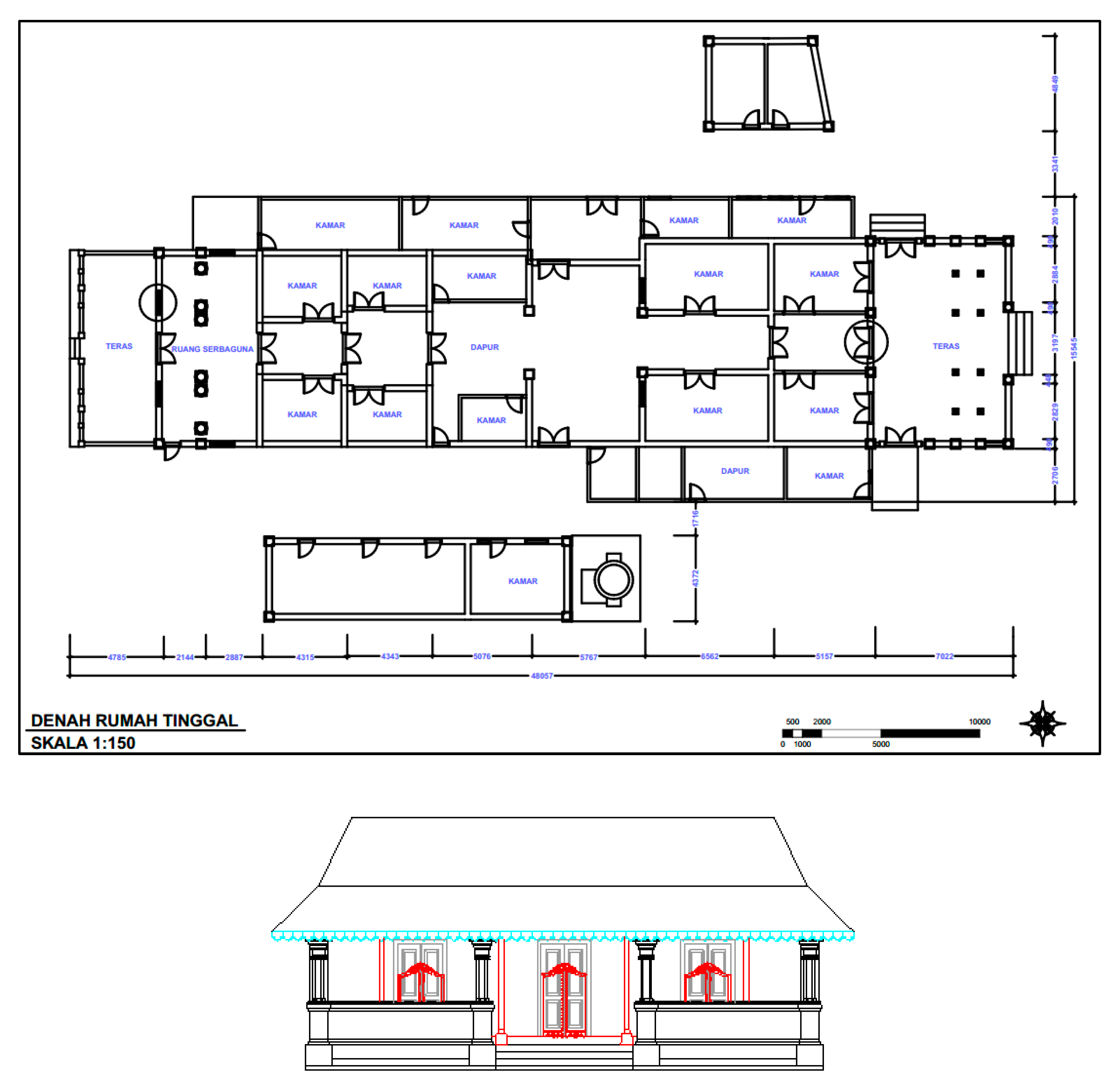
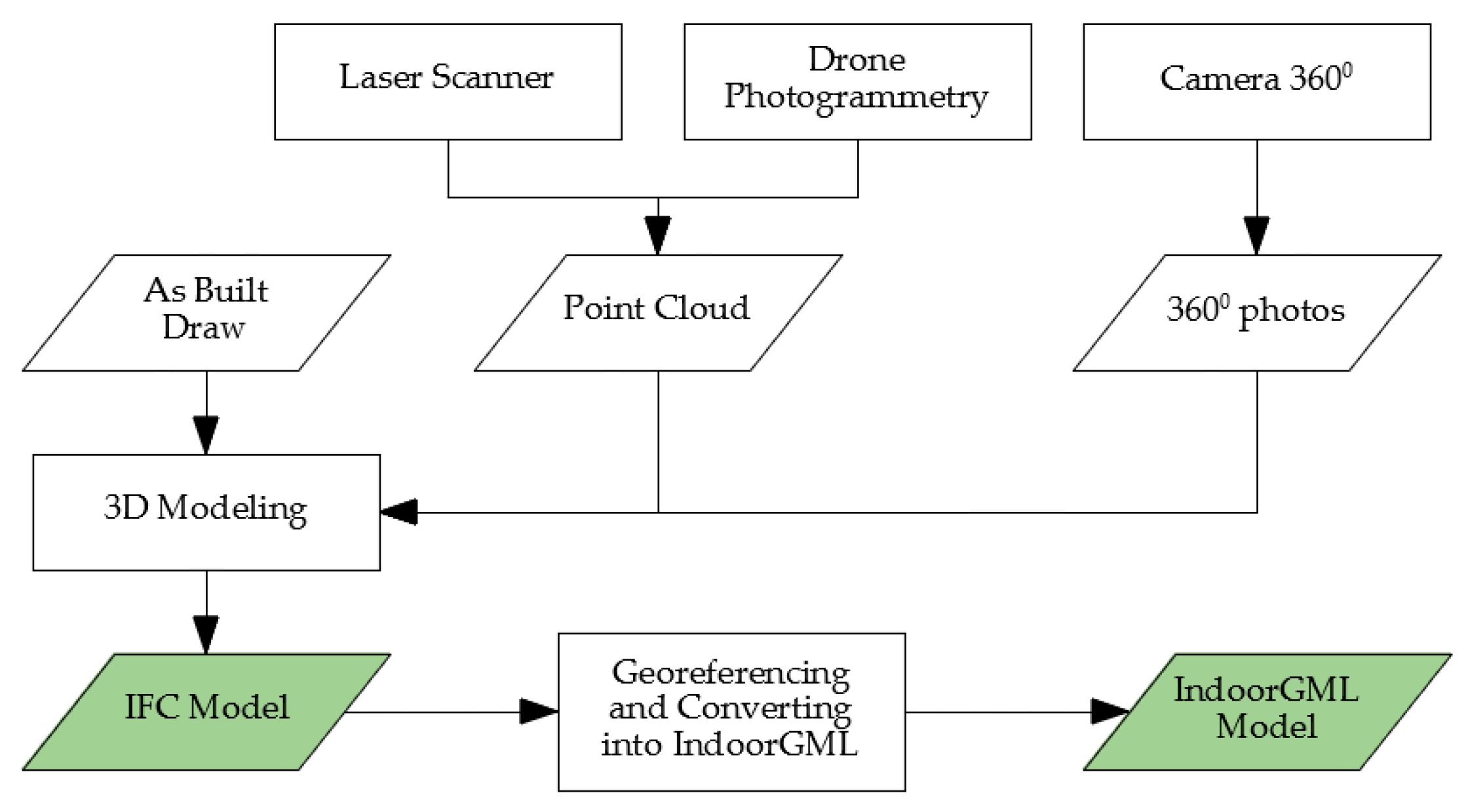
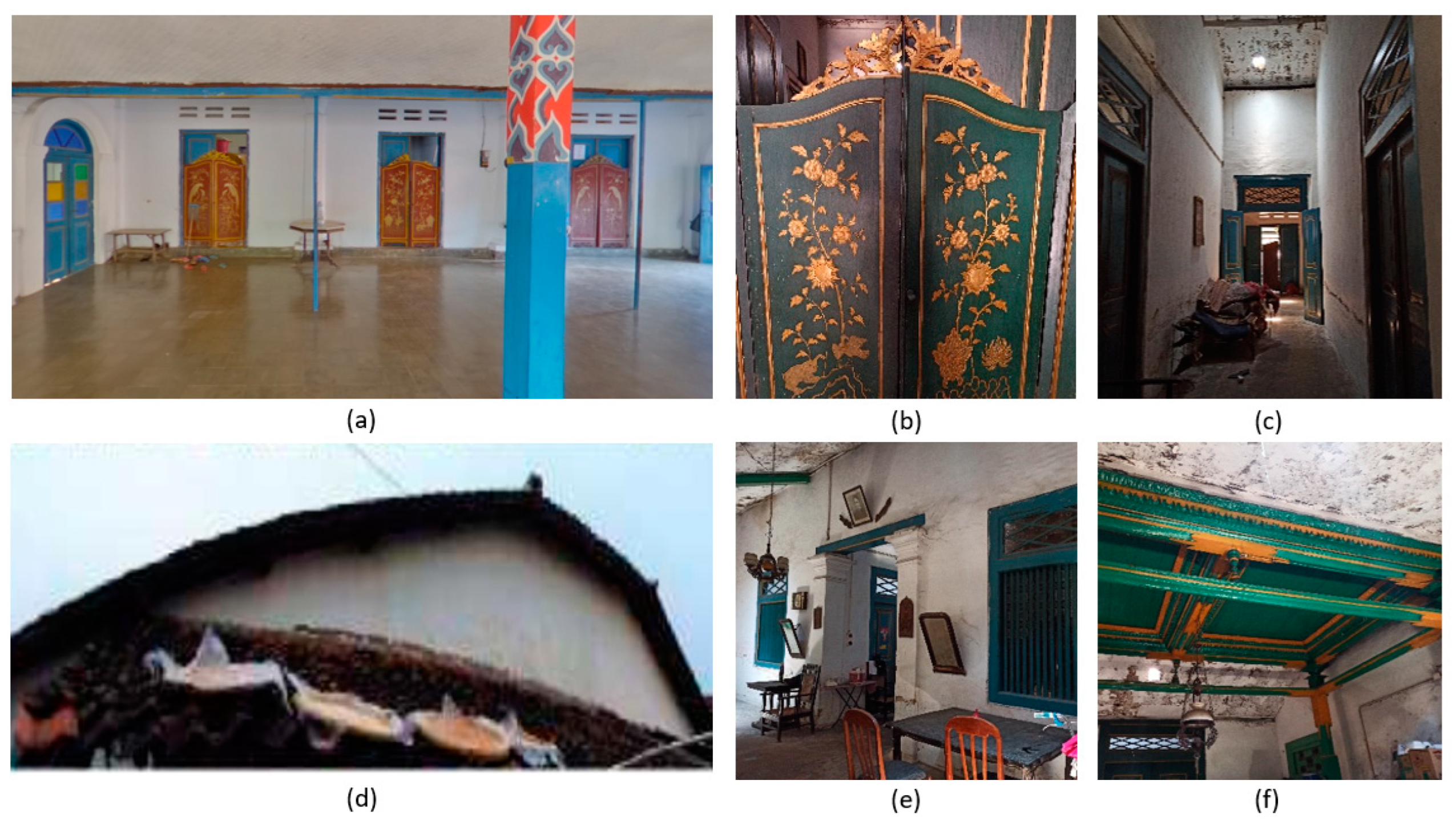
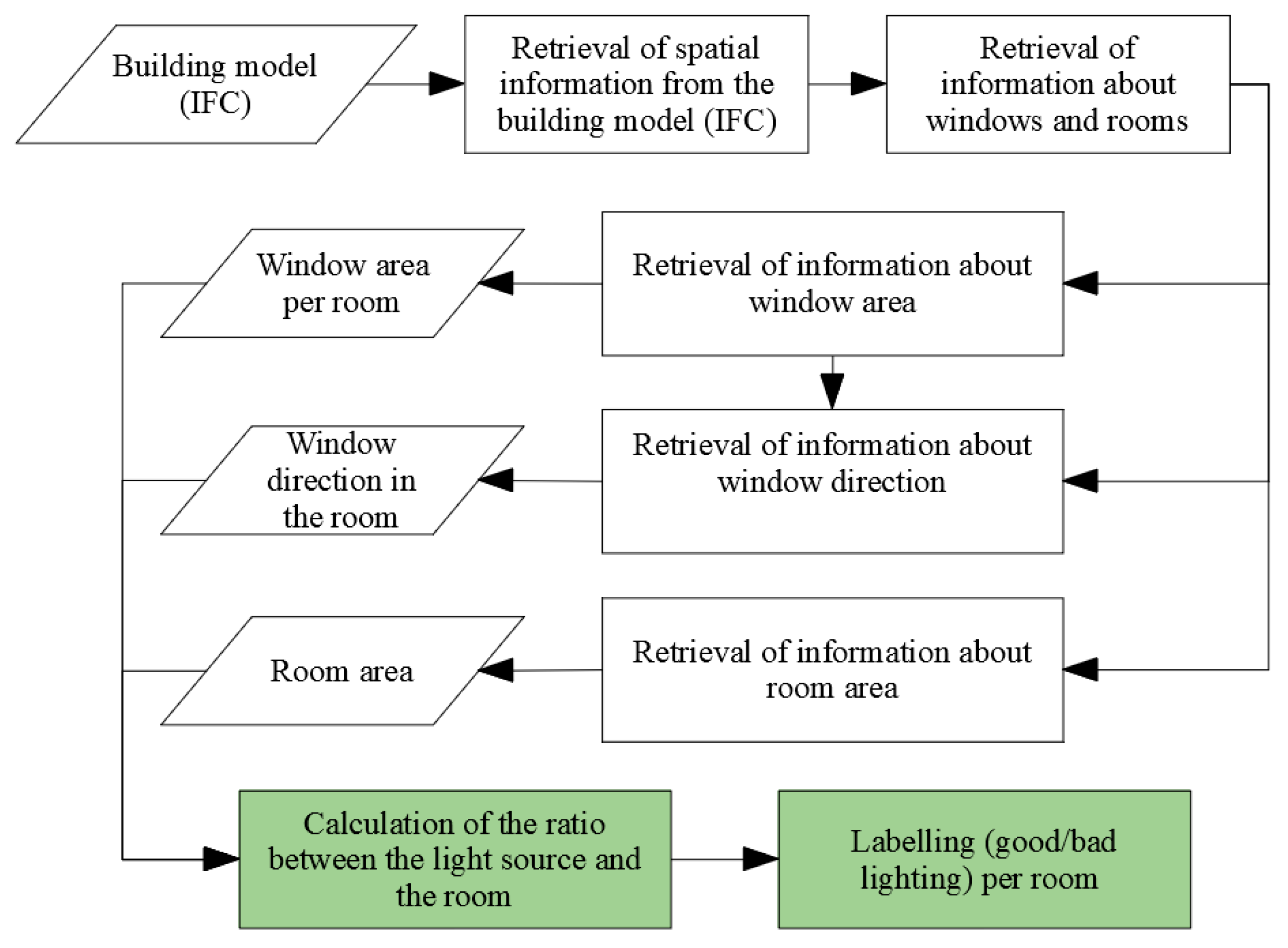
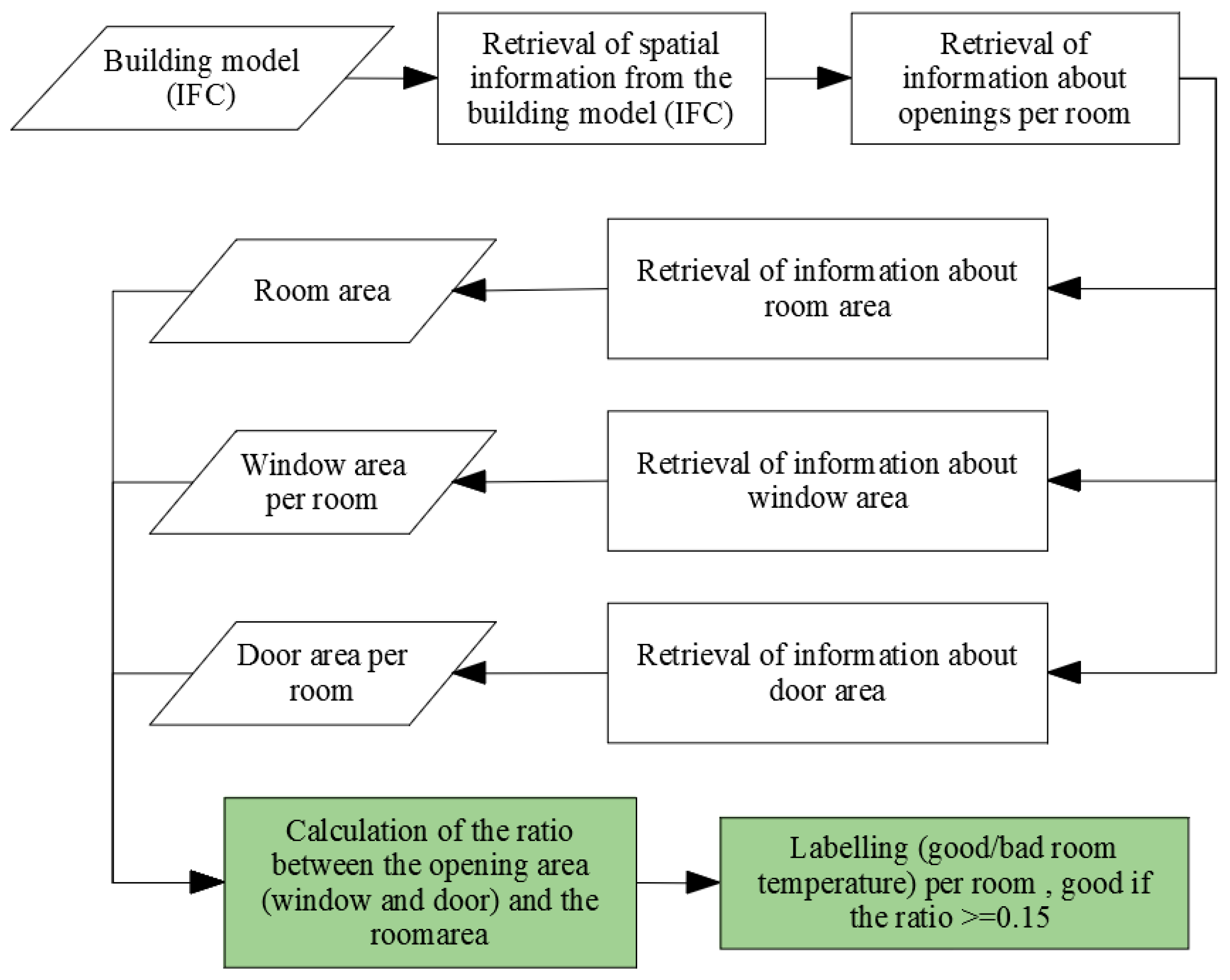
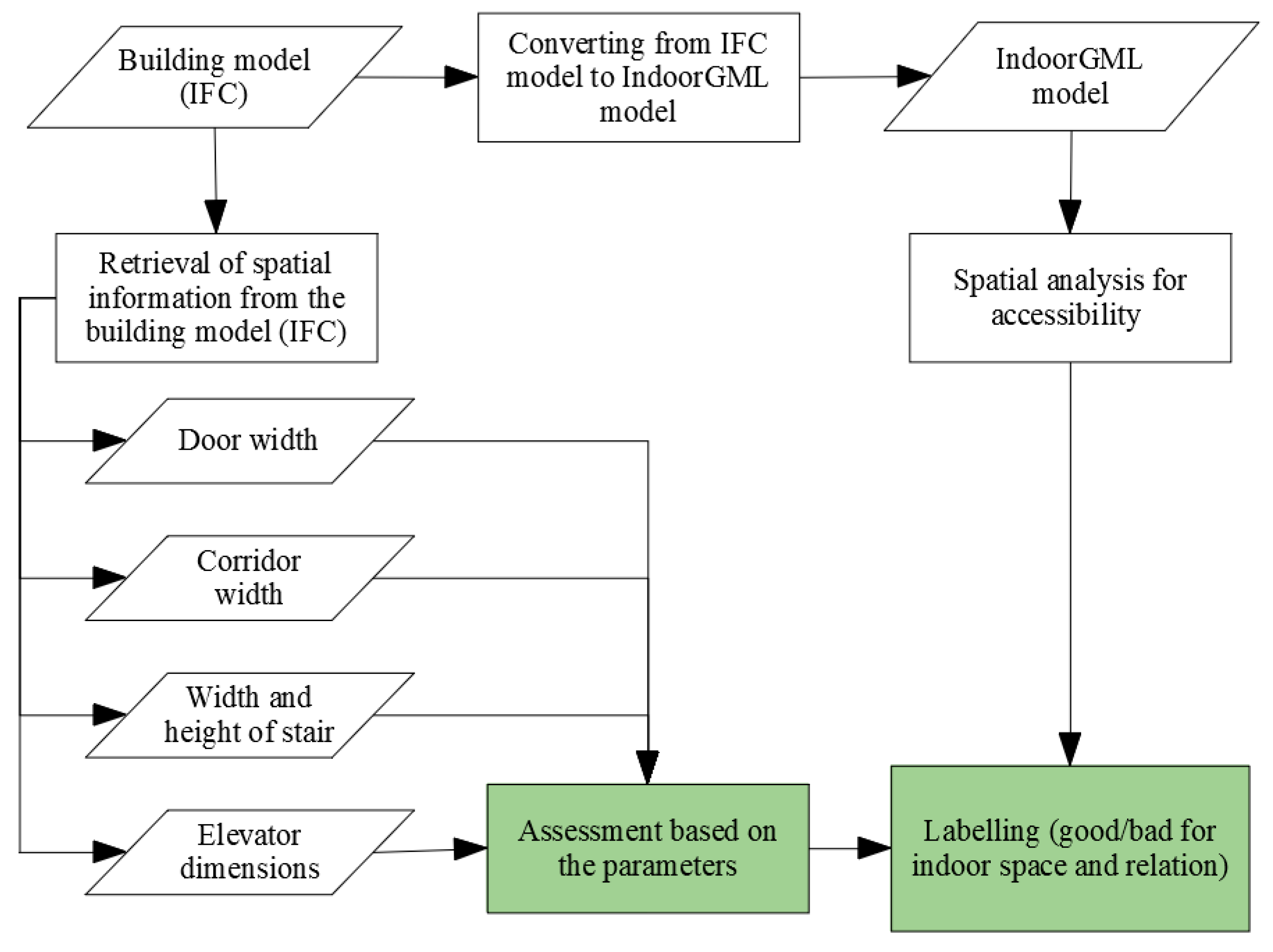
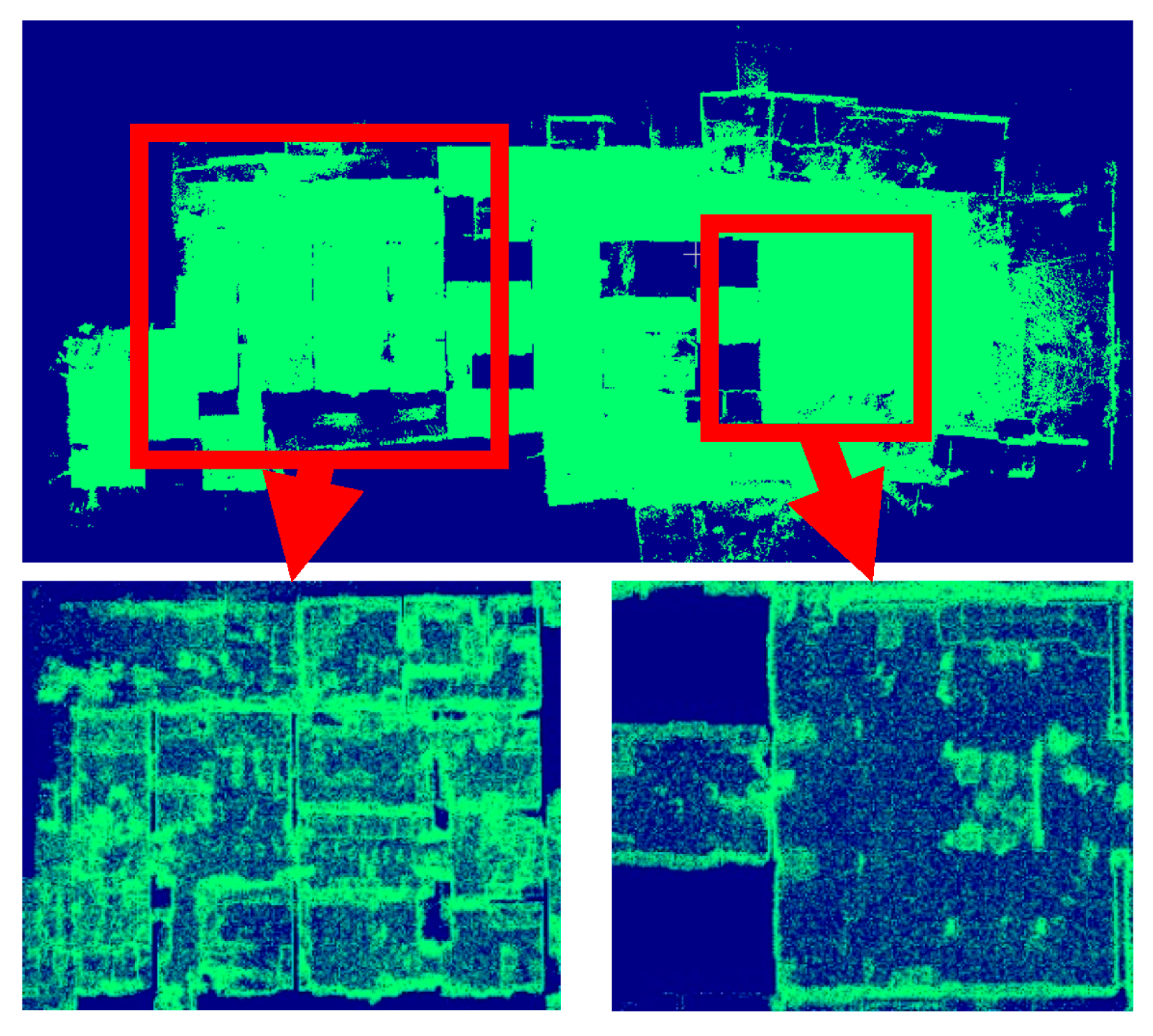

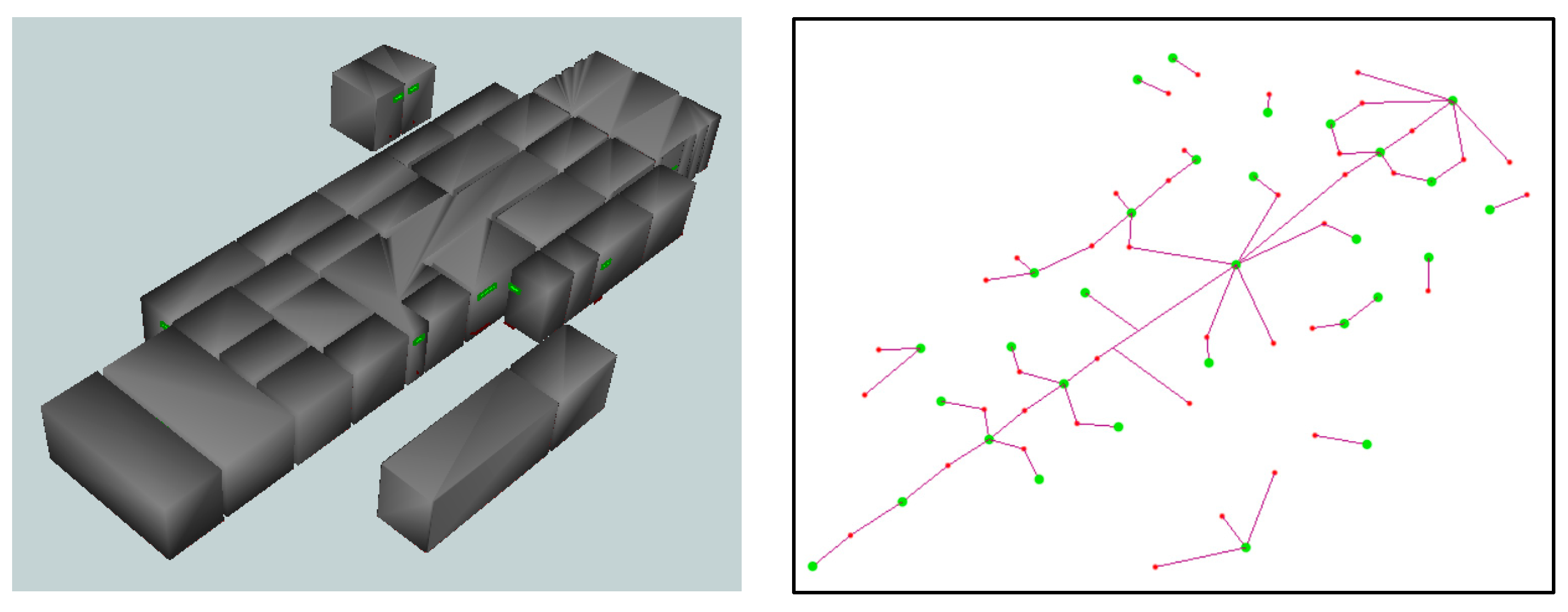
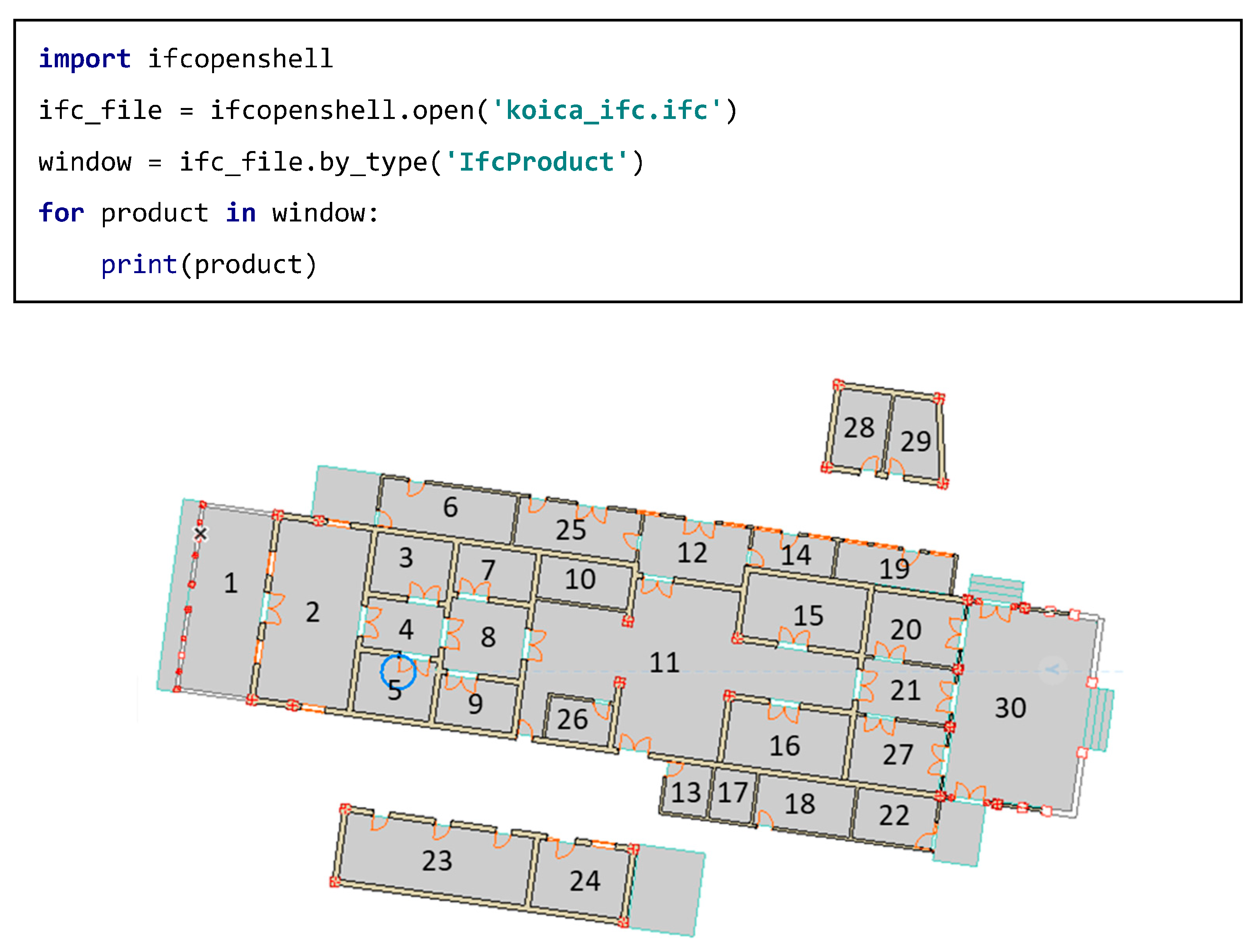
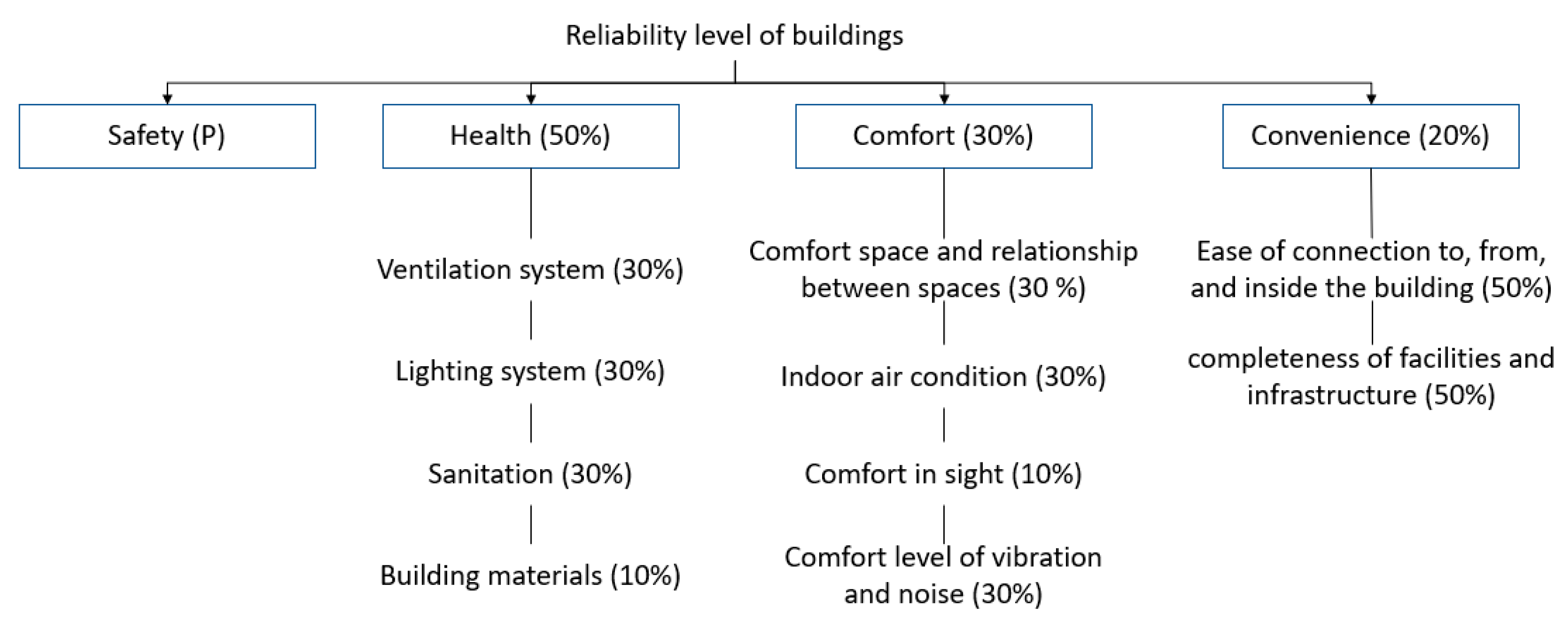

| Amount/Value | Ss1 | Ss2 | Sn1 | Sn2 | Sm1 |
|---|---|---|---|---|---|
| Parameter | 1 | 1 | 1 | 1 | 1 |
| Total Sample | 28 | 28 | 40 | 28 | 30 |
| Sample Complied | 27 | 5 | 40 | 28 | 30 |
| Value | 5 | 2 | 5 | 5 | 5 |
| Score | 100 | 40 | 100 | 100 | 100 |
| No. | Criteria/Sub-Criteria | Initial Score | Weight (%) | Final Score |
|---|---|---|---|---|
| 1 | Health (Ss) | 70 | 50 | 35 |
| 2 | Ventilation System (Ss1) | 100 | ||
| 3 | Lighting System (Ss2) | 40 | ||
| 4 | Comfort (Sn) | 100 | 30 | 30 |
| 5 | Comfort Space (Sn1) | 100 | ||
| 6 | Indoor Air Condition (Sn2) | 100 | ||
| 7 | Convenience (Sm) | 100 | 20 | 20 |
| 8 | Accessibility (Sm1) | 100 | ||
| Final Score (Sk) | 85 | |||
Disclaimer/Publisher’s Note: The statements, opinions and data contained in all publications are solely those of the individual author(s) and contributor(s) and not of MDPI and/or the editor(s). MDPI and/or the editor(s) disclaim responsibility for any injury to people or property resulting from any ideas, methods, instructions or products referred to in the content. |
© 2023 by the authors. Licensee MDPI, Basel, Switzerland. This article is an open access article distributed under the terms and conditions of the Creative Commons Attribution (CC BY) license (https://creativecommons.org/licenses/by/4.0/).
Share and Cite
Trisyanti, S.W.; Suwardhi, D.; Purnama, I.; Wikantika, K. A Preliminary Study of 3D Vernacular Documentation for Conservation and Evaluation: A Case Study in Keraton Kasepuhan Cirebon. Buildings 2023, 13, 546. https://doi.org/10.3390/buildings13020546
Trisyanti SW, Suwardhi D, Purnama I, Wikantika K. A Preliminary Study of 3D Vernacular Documentation for Conservation and Evaluation: A Case Study in Keraton Kasepuhan Cirebon. Buildings. 2023; 13(2):546. https://doi.org/10.3390/buildings13020546
Chicago/Turabian StyleTrisyanti, Shafarina Wahyu, Deni Suwardhi, Iwan Purnama, and Ketut Wikantika. 2023. "A Preliminary Study of 3D Vernacular Documentation for Conservation and Evaluation: A Case Study in Keraton Kasepuhan Cirebon" Buildings 13, no. 2: 546. https://doi.org/10.3390/buildings13020546
APA StyleTrisyanti, S. W., Suwardhi, D., Purnama, I., & Wikantika, K. (2023). A Preliminary Study of 3D Vernacular Documentation for Conservation and Evaluation: A Case Study in Keraton Kasepuhan Cirebon. Buildings, 13(2), 546. https://doi.org/10.3390/buildings13020546








